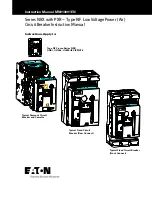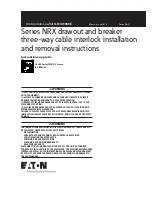
Powered by Safety
®
51
Maintenance
IB-60201
2) Vacuum Integrity
Refer to
Ch 4 Installation
,
d. p
lAcInG
c
IrcuIt
B
reAker
Into
S
ervIce
,
2) Vacuum Integrity
for information on vacuum integrity and
testing of vacuum interrupters.
3) Mechanical Adjustment of Vacuum
Interrupters
There are no adjustments required
for routine maintenance of a vacuum
interrupter assembly. There are several
factory adjustments which will vary over
the operating life of the vacuum interrupter.
Adjustments of these settings are only
necessary when repair requires the removal
or replacement of the vacuum interrupter.
Do not adjust these settings unnecessarily as
damage to the circuit breaker may result.
CAUTION
CAUTION
!
When it is necessary to remove or replace
the vacuum interrupter it should only be
done by a qualified technician or a Powell
service technician. Contact Powell for
further assistance at 1-800-480-7273.
d. o
ptIonAl
M
AIntenAnce
p
rocedureS
1) High Potential Tests
High potential tests are not required for
routine maintenance but are recommended
after a heavy fault interruption, any major
circuit breaker repair that involves the
primary current path or when the circuit
breaker has been in storage for an extended
time, especially in a damp location or other
adverse environment. In these cases, both
the High Voltage Insulation Integrity and
Control Voltage Insulation Integrity tests
should be performed. Refer to
Ch 4 Installation
,
d. p
lAcInG
c
IrcuIt
B
reAker
Into
S
ervIce
, for details of these procedures.
2) Timing
At normal control voltage, operate the
test source to the “close” position to close
the circuit breaker and record the closing
time. The closing time from energizing the
closing coil to vacuum interrupter contact
touch should not exceed the values in
the timing table. Again, at normal control
voltage, operate the test source to the
“open” position to open the circuit breaker
and record the opening time. The opening
time from energizing the shunt trip coil to
vacuum interrupter contact part should not
exceed the values in the timing table.
Table C Timing
Closing Time
Tripping Time
3 Cycle
≤80 ms
<35 ms
5 Cycle
≤80 ms
<50 ms








































